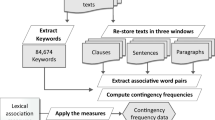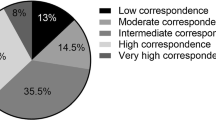Abstract
In recent years, word associations have played a key role in cognitive research. The goal of this study is to propose a new system called Tarvajeh to construct and analyze the association norms found in the Persian language. In this paper, we present Tarvajeh, a data set for Persian words in a continuous word association task. For data collection, cue words have been categorized into groups and then, 30 of them were presented to each participant in two phases. Afterward, the participants were asked to write the first three words that are related to the initial cue words. After data collection, Tarvajeh included 240 frequent Persian cues and more than 20,000 different responses. Furthermore, we also propose a method that allows participants to compare their responses as well as their subconscious mind with those of their peers using a unique graph that is tailored to their responses and is displayed to them. Finally, we compared our data with those of associated words in other languages. The comparison reveals that, for some cues, most associated words are the same, while for others, the most frequent responses are unique within each data set. In addition, some gender-related differences were observed with male participants spending more time on their responses than female participants.









Similar content being viewed by others
Notes
A group of synonym data elements that are considered semantically equivalent for the purposes of information retrieval.
A word that is more general than a given word (e.g. “animal” is a hypernym of “dog”).
A word that is more specific than a given word (e.g. “dog” is a hyponym of “animal”).
An opposite and inherently incompatible word (e.g. “white” is the antonym of “black”).
A word that makes up a part of a given word (e.g. “finger” is a meronym of “hand”).
Tar and Vajeh mean ‘network’ and ‘word’ in Persian, respectively. So Tarvajeh means ‘network of words’.
There is no single universal list of stop words used by all NLP tools, but the list of stop words used by NLTK (a popular tool for NLP) has been added to “Appendix 1”.
References
Anderson, John R. (1983). Cognitive science series. The architecture of cognition. Hillsdale, NJ, USA.
Bahrick, H. P. (1970). Two-phase model for prompted recall. Psychological Review, 77(3), 215.
Barsalou, L. W., Santos, A., Simmons, W. K., Wilson, C. D. (2008). Language and simulation in conceptual processing. In Symbols, embodiment, and meaning (pp. 245–283). Oxford: Oxford University Press.
Burke, D. M., & Peters, L. (1986). Word associations in old age: Evidence for consistency in semantic encoding during adulthood. Psychology and Aging, 1(4), 283.
Church, K. W., & Hanks, P. (1990). Word association norms, mutual information, and lexicography. Computational Linguistics, 16(1), 22–29.
Comesaña, M., Fraga, I., Moreira, A. J., Frade, C. S., & Soares, A. P. (2014). Free associate norms for 139 european portuguese words for children from different age groups. Behavior Research Methods, 46(2), 564–574.
Cramer, P. (1968). Word association. Cambridge: Academic Press.
cytoscape.org. URL https://cytoscape.org.
De Deyne, S., Storms, G. (2015). Word associations. In The Oxford handbook of the word.
De Deyne, S., Navarro, D. J., & Storms, G. (2013). Better explanations of lexical and semantic cognition using networks derived from continued rather than single-word associations. Behavior Research Methods, 45(2), 480–498.
De Deyne, S., & Storms, G. (2008). Word associations: Network and semantic properties. Behavior Research Methods, 40(1), 213–231.
Deese, J. (1966). The structure of associations in language and thought. Baltimore: Johns Hopkins University Press.
Dehkharghani, R., Shamsfard, M. (2009). Mapping Persian words to wordnet synsets. International Journal of Interactive Multimedia and Artificial Intelligence, 1(2), 6–12.
Fellbaum, C. (1998). WordNet: an electronic lexical database. Cambridge: MIT Press.
Fernández, Á., Diez, E., Alonso, M. Á., & Beato, M. S. (2004). Free-association norms for the Spanish names of the Snodgrass and Vanderwart pictures. Behavior Research Methods, Instruments, and Computers, 36(3), 577–583.
Ferrand, L., & Alario, F.-X. (1998). Normes d’associations verbales pour 366 noms d’objets concrets. L’Année psychologique, 98(4), 659–709.
Fodor, Imola K. (2002). A survey of dimension reduction techniques. Technical report, Lawrence Livermore National Lab., CA (US).
Galea, D., Bruza, P. (2015). Deriving word association networks from text corpora. In Proceedings of the EuroAsianPacific Joint Conference on Cognitive Science (EAPCogSci 2015) (Vol. 419, pp. 252–257).
Heath, D., Norton, D., Ringger, E., Ventura, D. (2013). Semantic models as a combination of free association norms and corpus-based correlations. In 2013 IEEE 7th International Conference on Semantic Computing (pp. 48–55).
im Walde, S. S., & Borgwaldt, S. R. (2015). Association norms for German noun compounds and their constituents. Behavior Research Methods, 47(4), 1199–1221.
John, R., Anderson, J. R., & Bower, G. H. (2014). Human associative memory. Hove: Psychology Press.
Joyce, T. (2005). Constructing a large-scale database of Japanese word associations. Glottometrics, 10, 82–99.
Kent, G. H., & Rosanoff, A. J. (1910). A study of association in insanity. American Journal of Psychiatry, 67(1), 37–96.
Kiss, G. R., Armstrong, C., Milroy, R., Piper, J. (1973). An associative thesaurus of english and its computer analysis. In The computer and literary studies (pp. 153–165).
Landauer, T. K., & Dumais, S. T. (1997). A solution to Plato’s problem: The latent semantic analysis theory of acquisition, induction, and representation of knowledge. Psychological Review, 104(2), 211.
Landauer, T. K., Foltz, P. W., & Laham, D. (1998). An introduction to latent semantic analysis. Discourse Processes, 25(2–3), 259–284.
Lund, C. B., Kevin, & and. (1997). Modelling parsing constraints with high-dimensional context space. Language and Cognitive Processes, 12(2–3), 177–210.
Luria, A. R. (1979). Jazyk i soznanie [language and cognition].
Macizo, P., Ariza, C. J. G., & Bajo, M. T. (2000). Associative norms of 58 Spanish words for children from 8 to 13 years old. Psicológica, 21(2), 287–300.
Mandera, P., Keuleers, E., & Brysbaert, M. (2017). Explaining human performance in psycholinguistic tasks with models of semantic similarity based on prediction and counting: A review and empirical validation. Journal of Memory and Language, 92, 57–78.
Manoiloff, L., Artstein, M., Canavoso, M. B., Fernández, L., & Segui, J. (2010). Expanded norms for 400 experimental pictures in an Argentinean Spanish-speaking population. Behavior Research Methods, 42(2), 452–460.
Marques, J. F. (2002). Normas de associação livre para 302 Palavras Portuguesas. Revista Portuguesa de Psicologia, 36, 35–43.
McRae, K., Khalkhali, S., Hare, M. (2012). Semantic and associative relations in adolescents and young adults: Examining a tenuous dichotomy. In The adolescent brain: Learning, reasoning, and decision making (pp. 39–66). American Psychological Association, US.
Mihalcea, R., Corley, C., Strapparava, C., et al. (2006). Corpus-based and knowledge-based measures of text semantic similarity. Aaai, 6, 775–780.
Montazery, M., Faili, H. (2010). Automatic Persian wordnet construction. In Proceedings of the 23rd International Conference on Computational Linguistics: Posters (pp. 846–850). Association for Computational Linguistics.
Montazery, M., & Faili, H. (2011). Unsupervised learning for Persian wordnet construction. Proceedings of the International Conference Recent Advances in Natural Language Processing, 2011, 302–308.
Mousavi, Z., Faili, H. (2017). Persian wordnet construction using supervised learning. arXiv preprint arXiv:1704.03223.
Nelson, D. L., & McEvoy, C. L. (1979). Encoding context and set size. Journal of Experimental Psychology: Human Learning and Memory, 5(3), 292.
Nelson, D. L., McEvoy, C. L., & Dennis, S. (2000). What is free association and what does it measure? Memory and Cognition, 28(6), 887–899.
Nelson, D. L., McEvoy, C. L., & Schreiber, T. A. (2004). The university of South Florida free association, rhyme, and word fragment norms. Behavior Research Methods, Instruments, and Computers, 36(3), 402–407.
Nelson, D. L., McKinney, V. M., Gee, N. R., & Janczura, G. A. (1998). Interpreting the influence of implicitly activated memories on recall and recognition. Psychological Review, 105(2), 299.
Paivio, A. (1990). Mental representations: A dual coding approach (Vol. 9). Oxford: Oxford University Press.
Palermo, D. S., Jenkins, J. J. (1964). Word association norms: Grade school through college.
Roediger, H. L., & McDermott, K. B. (1995). Creating false memories: Remembering words not presented in lists. Journal of Experimental Psychology: Learning, Memory, and Cognition, 21(4), 803.
Rouhizadeh, M., Shamsfard, M., Yarmohammadi, M. (2008). Building a wordnet for Persian verbs. In The 4th Global WordNet Conference, Hungary (pp. 406–412).
Russell, W. A., Jenkins, J. J. (1954). The complete Minnesota norms for responses to 100 words from the Kent–Rosanoff Word Association Test. Department of Psychology, University of Minnesota.
Russell, W. A. (1970). The complete german language norms for responses to 100 words from the Kent–Rosanoff word association test. Norms of word association (pp. 53–94). Amsterdam: Elsevier.
Ruts, W., De Deyne, S., Ameel, E., Vanpaemel, W., Verbeemen, T., & Storms, G. (2004). Dutch norm data for 13 semantic categories and 338 exemplars. Behavior Research Methods, Instruments, and Computers, 36(3), 506–515.
Shah, P., Joshi, S. (2013). Investigating temporal variations in the twitter hashtag graph.
Shamsfard, M., Jafari, H. S., Ilbeygi, M. (2010). Step-1: A set of fundamental tools for Persian text processing. In Conference on Language Resources and Evaluation.
Steyvers, M., Shiffrin, R. M., Nelson, D. L. (2005). Word association spaces for predicting semantic similarity effects in episodic memory.
Steyvers, M., & Tenenbaum, J. B. (2005). The large-scale structure of semantic networks: Statistical analyses and a model of semantic growth. Cognitive Science, 29(1), 41–78.
Tarvajeh network. http://webpages.iust.ac.ir/h_rahmani/Tarvajeh/Network.zip.
Tausczik, Y. R., & Pennebaker, J. W. (2010). The psychological meaning of words: Liwc and computerized text analysis methods. Journal of Language and Social Psychology, 29(1), 24–54.
Tresselt, M. E., & Mayzner, M. S. (1964). The kent-rosanoff word association: Word association norms as a function of age. Psychonomic Science, 1(1–12), 65–66.
Author information
Authors and Affiliations
Contributions
HR, The scientific supervisor of the project, finalized the manuscript and was in charge of overall directions and planning of Tarvajeh. FK implemented the GUI of Tarvajeh, Pre-processed the result, and analyzed the resulted network. AZ reviewed the literature and provided the initial version of the manuscript. RS and KA helped in the response gathering from varied participants.
Corresponding author
Ethics declarations
Conflict of interest
The authors declare that they have no conflict of interest.
Additional information
Publisher's Note
Springer Nature remains neutral with regard to jurisdictional claims in published maps and institutional affiliations.
Appendix 1
Rights and permissions
About this article
Cite this article
Karimkhani, F., Rahmani, H., Zare, A. et al. Tarvajeh: Word Association Norms for Persian Words. J Psycholinguist Res 50, 863–882 (2021). https://doi.org/10.1007/s10936-020-09751-2
Accepted:
Published:
Issue Date:
DOI: https://doi.org/10.1007/s10936-020-09751-2




